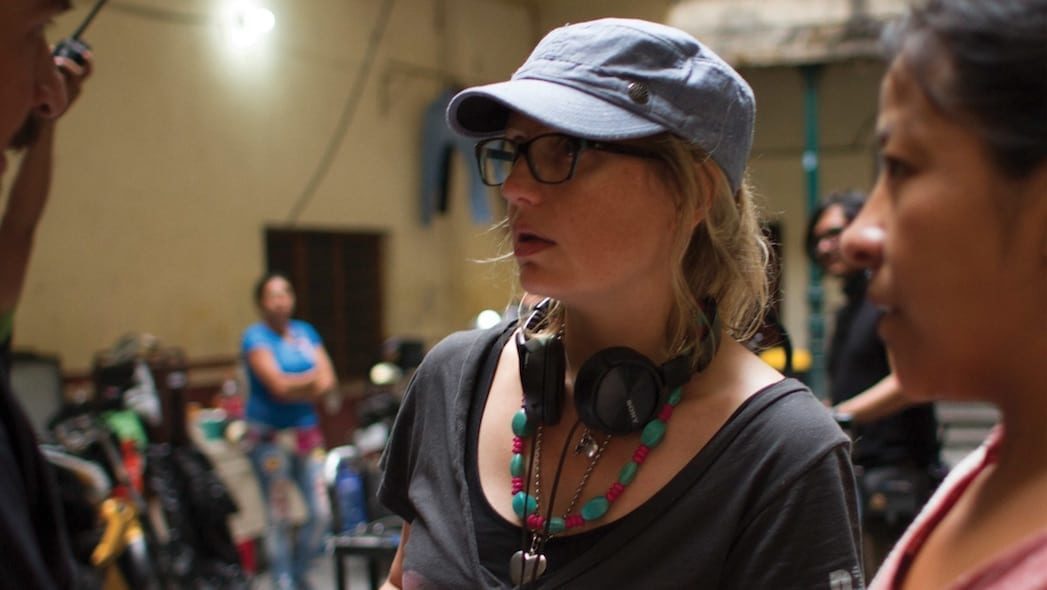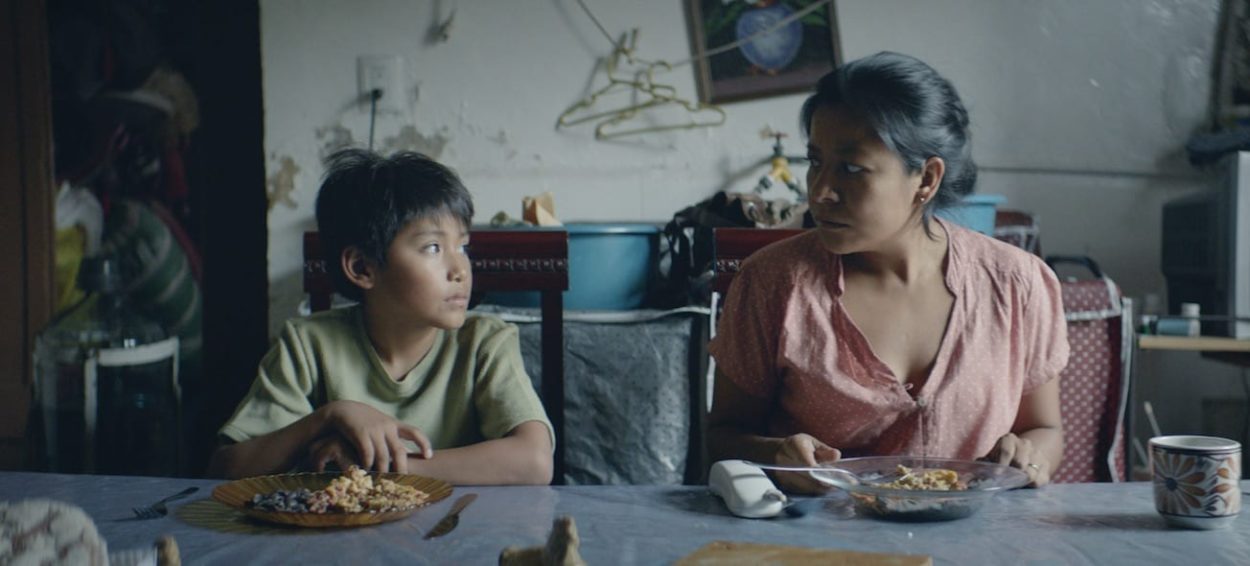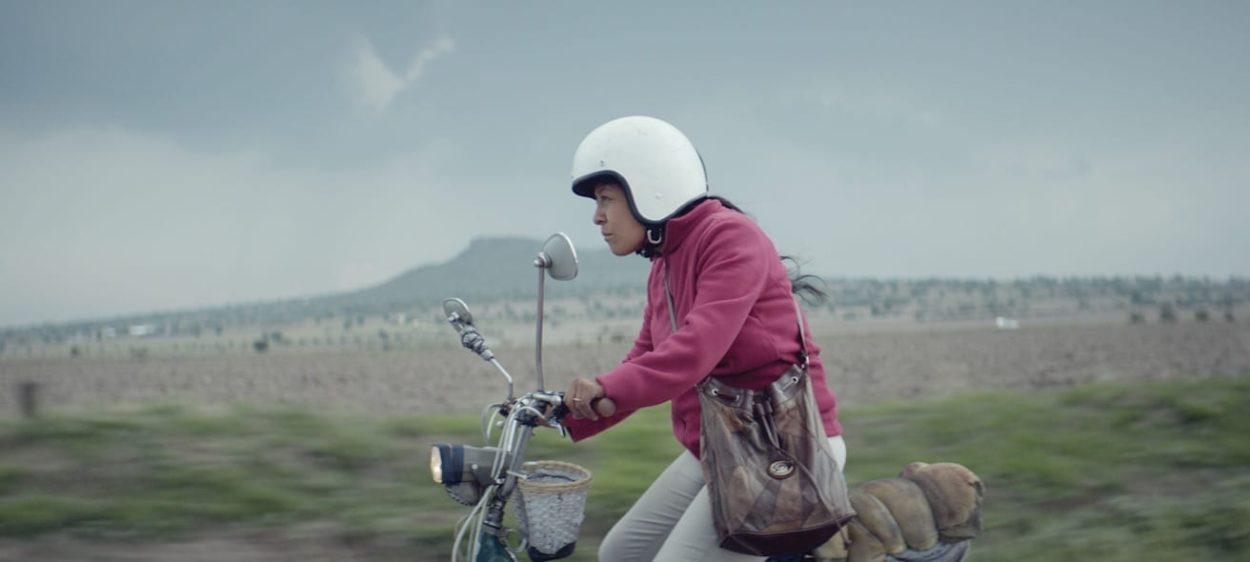What is your background that led you to make your film? (For instance, did you learn on the job or did you go to film school?) Is this your first film?
I’m thrilled to answer this as it’s actually my directorial debut and the film is only just recently finished. I have had no prior film school training; however my background and a gut full of self-belief has led me up to this moment.
Prior to now I had worked in advertising for 17 years, starting as a junior art director in London and working my way up to an international creative director in Paris. Writing and directing had been a long-term dream and I knew that if it was going to happen I’d need to take some serious steps towards it. So I quit my job last summer and really shook my life up.
I’d made many TV commercials during my time as an advertising creative and loved the access I had to all the different directors, often asking them so many questions. But it wasn’t until I quit work that it gave me the space to really explore this.
My fiancé, Jorge Aguilera, is an incredibly experienced commercials director in Mexico, and invited me to co-direct with him last year. Together we shot my first commercial in LA and Mexico featuring Chris Hemsworth. This was the first time I was securely on the other side of the production and I LOVED it. I had access to so many artistic people who were so passionate about their craft. I was hooked.
My self-belief and a desire to create something good is what essentially got me here. I pitched the Trump piñata film idea to the executive producers at Madrefoca in April (Vanessa Hernandez, Ale Saevich and Jorge Aguilera) and they got behind me and believed in me from the beginning. I’m truly grateful to them.
You seem to be familiar with Mexico – what is your experience with the country?
My first visit to the country was a trip organized a few years ago by a good friend of mine. We went to ride and camp with some cowboys over their land for a week. I spent three weeks in Mexico in total, both in the countryside and Mexico City – the country’s hospitality, colour and texture blew me away completely. All I could think about when we were leaving was ‘how would I next get back here?’
Time went on and a couple of years later I was about to move to Paris to take on a new advertising position, as an international creative director; the first job was to shoot an international commercial with a Mexican version featuring a local celebrity. I jumped at the chance to shoot in Mexico and we selected Jorge and the team at Madrefoca to do the job.
We were incredibly impressed with the level of production we received in Mexico: we had local cast and cast from LA, reams of great equipment, and the art direction was very adventurous. We continued the post-production there for a few days, and my French producer and I had the chance to explore the city and its incredible food.
Soon my life began in Paris, however with a newly acquired Mexican boyfriend on facetime! After a number of successful projects in the role, I felt ready and inspired to make the break from full-time advertising. I left the job and went back to Mexico and this is when I co-directed the Chris Hemsworth spot.
I’m from Yorkshire originally and I often joke that when flying in we’re arriving in ‘Mexico twinned with Yorkshire’. The reason being is I have always found such a sense of welcoming and hospitality with the people I have met – happy to share their country and their way of life. Through horse riding I have spent time with families from all sides of life in Mexico and often the people who have the least have the strongest sense of family, faith and love.
Did the idea for the script come to you as a bolt out of the blue?
At the beginning of April, I was riding on a horse ranch an hour outside of Mexico City for a few days. One day I found myself in the middle of the cactus filled countryside chatting to a wonderful lady from Washington DC who was trying to locate a Trump piñata.
I didn’t realize they existed at this point and thought they sounded hilarious, and so when I got back to the city and excitedly told Jorge about the idea, he suggested I write and film something on a topic that had so engaged me.
I started pitching the kind of visuals I’d like to see in the film together in my head and then wrote the story over the course of a week. During that time I would talk to my future sister-in-law Flor, who writes teens literature, about childhood in Mexico and how family really works there. This is how the idea of using a lime in the child’s hair came about, it’s what some Mexican people use instead of hair gel.
There was one idea above all else however that I was very clear about – I had to have a Donald Trump piñata on the back of a motorcycle! It was a great opportunity to take Trump piñata through the heart of Mexico, somewhere I’m sure the real Mr. Trump has never been, and to see the wind whistling through his paper hair. Donald Trump piñata meets Easy Rider. Amazing.
The evolution of the script is an interesting one. During the production phase the Trump campaign was beginning to gain more and more traction and he went from someone no one thought had a real hope of candidacy to being a front-runner. This meant that I had to allow for the story and the film to evolve a little during production.
It was in our second serious cut of the film when I realized with the editors that it would be great to get a Trump impersonator in there. I spoke to my friend Rupert Degas, nicknamed ‘man of a 1000 voices’, to see if he’d been working on a Trump impression… and that is where the fun really began. We had a Trump mouthpiece we had complete control over.
The story hangs together with some great editing – please tell us about the production. Did you storyboard in detail, to what extent did the story evolve in the edit?
Firstly thank you so much for the compliments on the editing – the team and I spent a great deal of time on this and so everyone will be happy to hear this feedback.
The production began, as I mentioned earlier, with me working out visuals I wanted to see in my head at first. From here I wrote the script and then we hit production as fast as we could. I made some basic storyboarding frames, and then transferred these to photo-boards, as I was shooting a lot of stills ideas on the location recces.
The use of mainly static composed shots and then handheld worked well for this film. I like the graphic composure we could achieve along side the energy and the movement of the hand-held.
We shot for five days and came away with a lot of material. On the first cut we compiled the footage and it came in at 15 minutes. But I was keen to take it down to a very digestible time length, as the primary purpose for the film was to be consumed easily online by a wide audience. Two further, quite hefty cuts later (including a change in the film title) we had the final film.
We cut in Mexico initially with Tamara Levy and then back in London with John Mayes – this was due to language and logistical purposes. We also brought the sound team into the cutting process early on, which allowed us to make sure we were story telling on every level. This was a very liberating thing to do and something I’d never had the chance to experience before in previous commercials.
What did you shoot it on?
The film was shot on the Arri Alexa by DP Matías Penachino. When it came to lenses, Matías suggested we use the Cooke Anamorphic lenses, which are very trendy right now – we particularly liked them for the way we could distort the shapes in camera with the barreling. It gave a feature to the film, and allowed us to subtly highlight the sometimes wonky-world of Mexico.
The portrait I wanted to create was one of a family who didn’t need much money and material things in life to be happy, more love and a commitment to the family. The team expertly showed this through the location and art direction and the lenses allowed us to further highlight this, adding to the personality of the place.
Location choices did at times create a few issues for sound, we were in old buildings and unusual places, but it was expertly handled by sound recordist Raúl Locatelli. He also helped create a wonderful sound bank of noises from Mexico. These were not so readily available in the UK and so when I returned to the UK we had all the elements we needed to create something that felt original and authentic.
Matías had done a great job with the cinematography and so it was important to make sure the approach to colour would continue in this vein. Working with Edwin Metternich at Framestore we created a wonderfully contemporary view of Mexico whilst making the most of everything captured in camera.
The cast are spot on – how did you go about finding them?
The casting was a huge combined effort from both the casting agent and crew members alike.
Our casting agent and Ariel winning actress, Ursula Pruneda, introduced me to some really wonderful people throughout the process – including the characters of the mother and father Ariel winner Monica del Carmen and Fermín Martínez.
Monica suggested a young boy she had previously worked with, Abraham Espíndola, who I met at a later session. Abraham was just eight years old at the time and had recently lost his front teeth, which he was a little nervous about. I thought this was simply charming and as we ran through the casting session I loved what I was seeing.
The 1st and 2nd ADs brought two other great cast members to the table: the grandmother Mary Paz Mata and the mystic man Ángel Garnica. Mary is a very famous Mexican actress and it was arranged that I’d first meet her one afternoon in the Zócalo (you’ll probably know it, it’s the square that was used for the opening sequence in the James Bond film Spectre). Mary said she was happy to come and work with us and to help the next generation of filmmakers on with their careers.
Ángel had worked with our 2nd AD before on a content film shot in Mexico, starring Harvey Keitel and David Beckham. We talked a great deal about spiritual rituals in Mexico and the scene he performs in the cave is called Limpia, it’s a cleaning process of bad spirits and energy.
It was a very varied casting process outside of the usual confines I have attended, and I think this adds to the spirit of the film. When I sat and looked at everyone we had I was incredibly happy with my choices. The final casting was with Rupert Degas, a friend of mine I had worked with over the years on commercials. Rupert is an incredibly talented and experienced voice artist and having the opportunity to bring him into this process was brilliant.
What was your process for directing the cast – did you have time for rehearsals?
The cast obviously had school and busy schedules to work around but we created a few rehearsal days before the shoot. There was going to be a vast amount of shots to cover over the course of five days. I had one-on-one sessions with each character and then we focused on the key scenes featuring Abraham in rehearsals.
There were many things to consider working with Abraham, I wanted to minimize the number of new situations that might drain him on shoot days and to also create a muscle and thought memory for him ready for when he came to set. I had quite a large crew, which could be easily distracting so I worked with a children’s acting coach, Ricardo White, who became my direct line working with Abraham. Only Ricardo was allowed to give the direction I wanted to Abraham so there was no confusion. My Spanish is still basic and so there could be no room for error due to my shortcomings.
Although I might look back and think it was crazy to do my first short in a language that’s not my first fluent one, I do think I prepared myself for all eventualities and the results came off for me. It allowed me to stay strong and focused on a visually told narrative piece with very few key lines.
Anything else you’d like to share?
I have spoken here about a few key production members in the team but I just want to make a broad acknowledgement to my entire crew, during the pre, production, post and now press and social phases. I have worked with some incredibly talented and experienced people at every step, who have engaged with an idea and come together to take me on an incredible journey.
There are so many stories and approaches we took in every phase of this film, it is a pleasure to be able to share with you a few of them. I feel like I set myself some ambitious moments with this film, but what came from those are learnings and solutions I would never have expected to embark upon, and it has been a huge and wonderfully rewarding learning curve.
Going forward I will continue to set myself these new big challenges, as although they are tough at the time, I feel like I have thrived in the situation and brought some wonderful people together.
LINKS
















